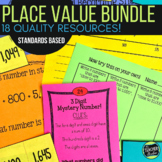Place Value Sequencing and Comparison Lessons and Activities
- PDF
Also included in
- Looking for a ton of hands-on, place value lessons that are low ink and ready to teach? This BUNDLED set contains all the instructions, reproducibles, and student activity sheets from the three separately sold place value sets (3-5 hands-on activities EACH)1. Hands On Decimal Sequencing2. Hands OnPrice $11.60Original Price $14.50Save $2.90
- This place value bundle includes 18 quality place value activities that can be used successfully with grades 2-5. This may seem like a big grade level range, but—as you know—each grade comes with students who need work both above and below the place value standards assigned to them. The resources arPrice $39.00Original Price $74.25Save $35.25
Description
The Common Core and other rigorous standards clearly want students to be able to work flexibly with large numbers and place value concepts. This set of 4 place value lessons help build number sense and an understanding of how our base 10 system works. Each activity can be done as whole class interactive demonstrations or in small groups. Directions are included.
Each also has a follow up independent practice activity that can be used as homework, review, or even as a place value assessment to check understanding.
They are designed to be low ink for easy copying and are very "hands on" for students! These are based off of the Common Core Standards for 4th grade…3rd grade leads to these and 5th grade continues! All are based on “Generalize place value understanding for multi-digit whole numbers”.
These 5 activities (4 "lessons" and 1 game) are geared toward teaching and/or reviewing large number concepts and sequencing including...
- -Sequencing
- -Rounding/estimating
- -Comparing expanded, “number names” and numerals
------------------------------------------------------------------------------
Looking for MORE place value resources?
Number Line Work to 1,000 (more versions available)
Place Value Sequencing Activities
Two Deep Thinking Place Value Activities
Bundle of FOUR Place Value Games
Standard and Expanded Form Task Cards
Place Value Formative Assessments
------------------------------------------------------------------------------
All rights reserved by ©The Teacher Studio. Purchase of this resource entitles the purchaser the right to reproduce the pages in limited quantities for single classroom use only. Duplication for an entire school, an entire school system, or commercial purposes is strictly forbidden without written permission from the author at fourthgradestudio@gmail.com. Additional licenses are available at a reduced price.







